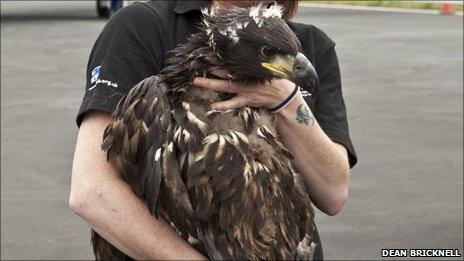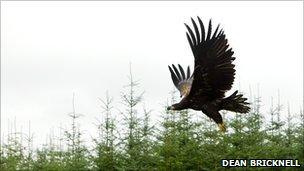White-tailed sea eagles flown in to Scotland
- Published

The eagles are part of a scheme to reintroduce the birds in eastern Scotland
A new batch of 16 young sea eagles have been set up in secret aviaries over the weekend as part of ongoing efforts to reintroduce them across Scotland.
The white-tailed eaglets arrived at Edinburgh Airport on Friday after being flown in as a gift from Norway.
The group is being reared in Fife until they are strong enough to fledge.
The East Scotland Sea Eagle reintroduction scheme is run by RSPB Scotland, Scottish Natural Heritage and Forestry Commission Scotland.
Last year, 19 white-tailed sea eagles were released into the wild in Fife. They are the UK's largest bird of prey.
Now in its fifth year, the initiative has been releasing the species into eastern Scotland, with the long-term hope of restoring the birds across the full extent of their former range.
The latest group were welcomed at Edinburgh Airport by Norwegian Consul Mona Rohne and Environment Minister Stewart Stevenson.

Last year 19 sea eagles were released into the wild
Mr Stevenson said: "The reintroduction project has been a long haul but the care and effort invested has achieved remarkable results - the white-tailed sea eagle is now a frequent and glorious sight in Scotland's skies.
"Undoubtedly a major draw - both for local and visiting wildlife watchers - the return of these magnificent birds to take their place in Scotland's rich biodiversity, has also provided a significant tourist attraction."
RSPB Scotland said there were now a record-breaking 52 breeding pairs of the species in Scotland, and although the majority of the population remains on the west, the species is regularly spotted in eastern and central areas.
Claire Smith, RSPB east Scotland sea eagle officer, said: "All the birds in the east coast population are fitted with radio and wing tags so we can keep track of their movements.
"Since the project began in 2007 we've had well over 2,500 reported sightings - this includes birds in the surrounding area of Tayside and Fife, but also further north in places like Orkney and four birds have wandered into northern England, being spotted in Northumberland, on the Solway and Lincolnshire.
"We're also pleased to see that east and west coast populations are mixing, which is a positive sign for the future."
- Published4 November 2010
- Published20 August 2010
- Published27 June 2010